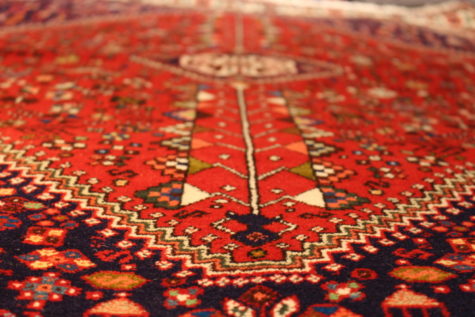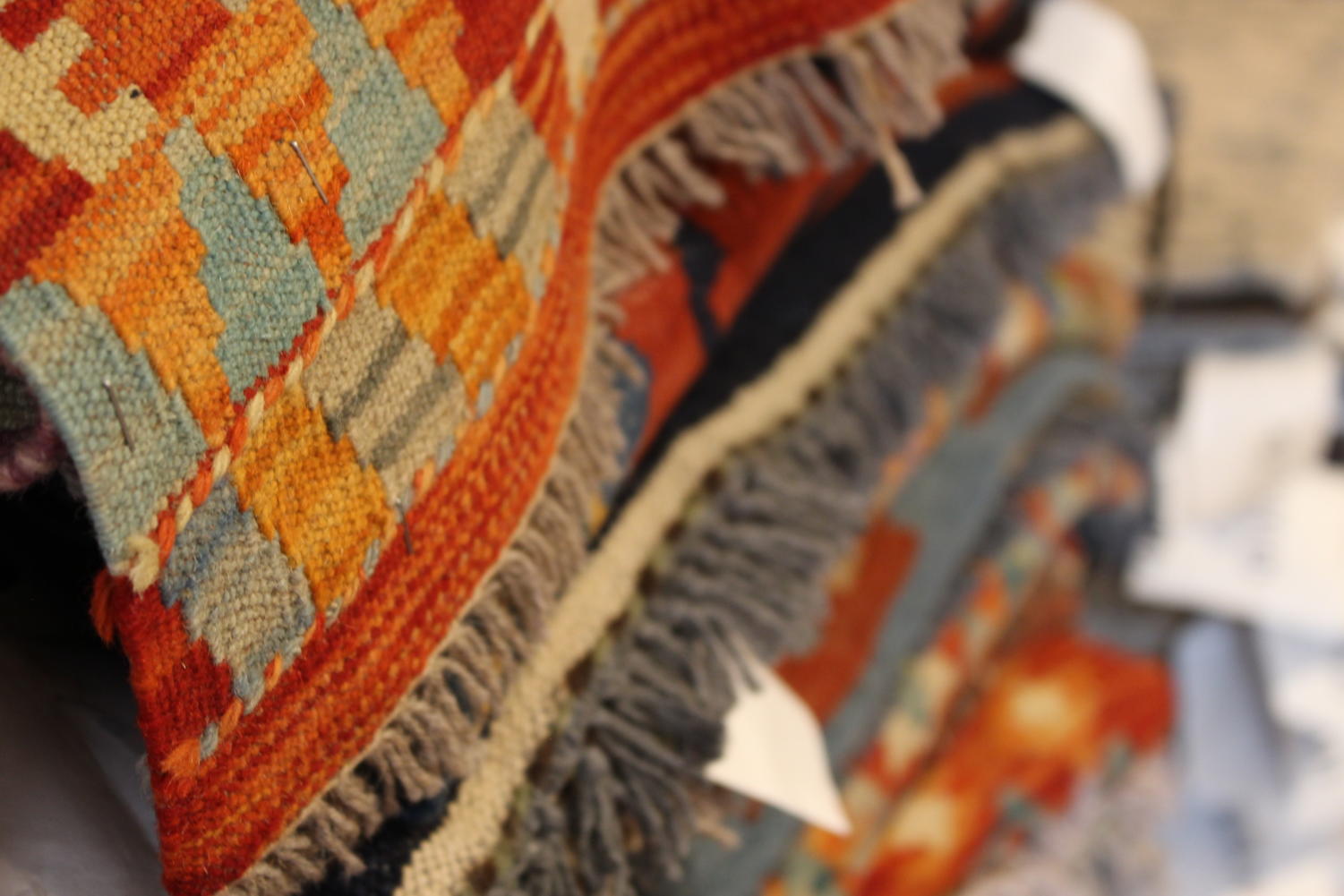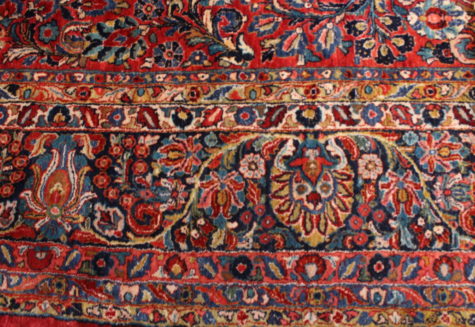Your donation will support the student journalists of the Evanstonian. We are planning a big trip to the Journalism Educators Association conference in Nashville in November 2025, and any support will go towards making that trip a reality. Contributions will appear as a charge from SNOSite. Donations are NOT tax-deductible.
Weaving cultures together
Rug stores found their home on Chicago Ave. over the last century as immigrants found footing in rug business
April 20, 2023
As you walk through Evanston’s commercial district, the sounds of cars whirring and people stirring are overwhelming and exciting all at once. The ‘L’ Train roars by as Evanston’s inhabitants pass restaurants, auto shops and endless rows of apartment buildings. But hidden within the lively city is one of Evanston’s greatest mysteries: the abundance of rug stores on the Main-Dempster mile.
Within a single mile-long stretch of road are nine rug stores and there are several more throughout Evanston. While some sell oriental rugs and others sell Persian rugs, they all exist within close proximity to one another. Over the years, Evanston residents have developed many theories as to why there are so many stores so close together. Jacob Bennett, a junior at ETHS and Chicago Avenue resident, gives us an example.
“My theory is that they could be a front or something,” he says. “I don’t know how many people in this area need rugs, so it might not be their sole purpose.”
A hand-woven, antique oriental rug isn’t just your run-of-the-mill piece of furniture. Rugs are a luxury item; they are incredibly hard to make–hand-woven ones especially–and often cost weeks of skill-intensive labor for even the most gifted weaver. Because they’re so ornate, rugs are incredibly expensive. The price widely varies based on material, size and the type of rug, but they can cost anywhere from a few thousand to over $10,000. Because of this, just a few rug sales are enough to keep a store open for an extensive period of time. Ultimately, rugs–and antique rugs in particular–are a collectors item.
 In addition to their intricate nature, rugs also have a complex history. The first rugs were made over 5,000 years ago, and the oldest surviving rug dates back to 500 BC. Rugs were primarily made in the Middle East, where nomadic tribes used animal skins as carpeting in their homes. They were a popular commodity for thousands of years, and what started as a local luxury in the Middle East spread across Europe and Asia with the advent of the Silk Road around 120 BC. Rugs from what is today Iran and the Arabian Peninsula were wrapped under the label “Persian Rugs,” though this particular style was also being made all over modern-day Iraq, Armenia, Syria and Afghanistan. These rugs found their way into the royal courts of the Roman Empire and the Chinese Han dynasty. Imperial aristocrats loved the intricate design, and they became a mainstay in the estates and mansions of high society. Over 2,000 years later, the rug craze has persisted and they remain a staple of luxury around the world.
In addition to their intricate nature, rugs also have a complex history. The first rugs were made over 5,000 years ago, and the oldest surviving rug dates back to 500 BC. Rugs were primarily made in the Middle East, where nomadic tribes used animal skins as carpeting in their homes. They were a popular commodity for thousands of years, and what started as a local luxury in the Middle East spread across Europe and Asia with the advent of the Silk Road around 120 BC. Rugs from what is today Iran and the Arabian Peninsula were wrapped under the label “Persian Rugs,” though this particular style was also being made all over modern-day Iraq, Armenia, Syria and Afghanistan. These rugs found their way into the royal courts of the Roman Empire and the Chinese Han dynasty. Imperial aristocrats loved the intricate design, and they became a mainstay in the estates and mansions of high society. Over 2,000 years later, the rug craze has persisted and they remain a staple of luxury around the world.
During World War I, the Ottomans faced both military disaster and domestic revolt. Ethnic minorities in the empire were tired of persecution and opted to revolt against Ottoman rule with the hope that the major powers would grant them independence when the war was over. To maintain stability and foster confidence in the Ottoman government, the administration sought to find a scapegoat. They chose the ethnic Armenian population, a significant minority within the empire and accused them of sabotaging the war effort, staging mutinies and fanning the flames of revolt elsewhere. Basically every inadequacy of the Ottoman administration was blamed on the Armenian people, and they became the target of one of the worst atrocities of the war: the Armenian Genocide. Armenian men, women and children were deprived of food and water and forced to march across the Syrian desert. By the time the war was over, over a million Armenians were killed.
Throughout the course of the war, many Armenian families moved to Chicago, fleeing the genocide. Many of them came with little or no money, but brought one crucial skill with them: weaving.
Carney Minasian, whose grandparents were refugees of persecution in Armenia, now co-owns Evanston’s Minasian Rug Company with his brother.
“A lot of [Armenian refugees] came to the U.S. in groups,” Minasian says. “I [knew] someone in Chicago [so my family] decided to go to Chicago. Like other ethnic groups, they had no land ownership; they had nothing. [But] they knew the rug business. They set up shops [and established] local businesses…It was a small community and everyone was coming from the old country, so they all banded together and helped each other. Even though they were competitors, they all knew each other.”
For this persecuted group, the foremost priority was to create a community in a land that was foreign to them. As a result, good business fell by the wayside, with multiple rug stores setting up shop in close proximity to one another. Interestingly, that didn’t restrict lucrative business.
“[The stores] didn’t cut into each other as much as you’d think they would because some stores had certain things that other dealers don’t,” Minasian says. “[But] they all have some of the same stuff so there’s business for everybody.”
While the stores were friendly with one another and each offered their own speciality, competition still existed. Sometimes, stores would even try to draw away their competitors’ customers.
“There were some men taking advantage of the fact that there’s established dealers here,” Minasian states. “So they look around, and they go, ‘Oh, god, what better place to put a rug store and catch people just driving by to that other store.’ Even if they didn’t drive there because of that rug dealer, if they go for another rug dealer but saw that place, [and] they say, ‘Well, we’ll see what they have.’ There was a lot of that.”
But why did these immigrants come to Evanston rather than a more lucrative market like downtown Chicago? To answer that question, we need to talk to Shams Frough. Frough is the owner of Kapisa Rugs, located on Chicago near Main. He started Kapisa Rugs after immigrating from Afghanistan during the pandemic, and he sought to support weavers back home after the Taliban takeover in 2021. He was a translator for the U.S. military, and although he managed to get out, many of his family members are still there.
“I’m probably the youngest person to ever start a rug store here,” Frough says. “The people here have been doing business in the area for decades, but our prices keep us very competitive. Evanston is a rug town. You have big houses and people who can afford them, and you have people who are interested in that sort of luxury item.”
The rug business persisted in the area throughout the 1920s and World War II, but the dynamics shifted after the war. America’s culture was changing, and the new styles of interior design left rugs abandoned in favor of carpeting. The newfound popularity of carpeting was for aesthetic and practical reasons. Aesthetically, at a time of widespread conformity, the popularity of carpeting appealed to people across the country. Practically, carpeting was simply easier to clean. Consumers were using vacuums to clean entire rooms of carpeting in under thirty minutes, while luxury rugs took hours of deep cleaning and usually needed to be cleaned by a professional.
“Nobody was buying rugs anymore,” Minasian voices.
The sudden disinterest in rugs eventually faded, and by the 1970s, rugs were once again becoming popular in Western countries.
“For example, in Germany, it became very, very popular to have a certain kind of rug called a Persian sarouk. It was a status symbol for the middle class, just like a color TV was here in this country,” Minasian said.
Following the 1979 Iranian revolution, millions of people fled Iran to avoid the violent and fiercely anti-opposition government. Similarly to past decades, many of these families had experience making and selling Persian rugs, so they started to establish stores in the area.
“A lot of Iranian families started to move to the U.S when the Shah got kicked out. So there’s a whole exodus out of Iran, and these dealers did the same thing that [Armenians] did when we came over, and they set up shops, because that was all they knew,” Minasian explains.
Today, rugs come in all shapes and sizes, and there are all sorts of sizes, colors, textures and materials that make a rug unique.
“A customer might come in with very specific parameters,” Minasian says. “I had a guy walk in the other day and he says, ‘I need rugs for three different areas: I need a 12 and a half foot by 20 foot rug, I need a 14 foot by 18 foot rug and a 13 foot by 25 foot rug. And I want them all antique and I don’t want any red ones or blue ones.’”
,If a store doesn’t have those specific rugs, a customer might go to another rug store, and oftentimes customers will go to 3 or 4 stores before actually finding a rug that suits their needs.
“If they don’t find what they’re looking for at my store, they’ll definitely find it at another store,” Frough adds.
In the modern age, the significance of stores’ proximity to each other has decreased as businesses have had to adapt to new technology and a changing market.
“We used to have 26 stores that we supplied rugs for. But those days are gone; websites replaced a lot of that,” Minasian states. “If I relied on walk-in customers, I would be out of business. We’re very friendly to local customers, but to be honest, a very small percentage of our business comes from them. The ideal mix is to have a brick and mortar store and a very strong internet presence.”
Stores are using the internet to reach a wider audience and broaden their customer base, moving past the local competition that had defined the past century.
The new focus on internet sales has given these stores clientele from around the world, allowing businesses to sell more rugs at a faster rate than before. The rug business has appealed to immigrants for generations because it provides an easy opportunity to establish oneself in a new country. And today, all you need is a few rugs and a website to set up shop.
Rugs have been a staple of Evanston and the North Shore for well over a hundred years, and entire immigrant communities have sprung up and flourished around them. They’ve decorated our homes and brought people together. Furthermore, rugs are a catalyst for expression. Not just in the incredible artwork woven into ornate fabric, but in the many cultures that thrive through them. In this sense, Evanston isn’t just a random hotspot for rug stores; it’s an art gallery.




Shams Frough • May 28, 2023 at 9:35 pm
There are many papers written about the rug stores in Evanston and the history behind it.
But to be honest, hats of Frank, none is as detailed, well researched and informative as yours.
Well done!